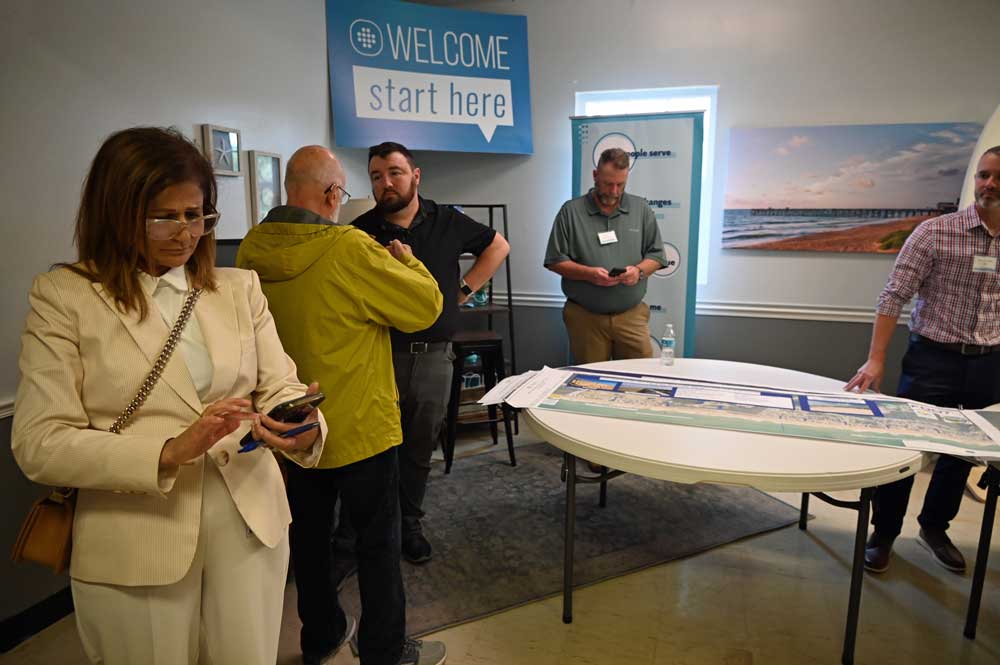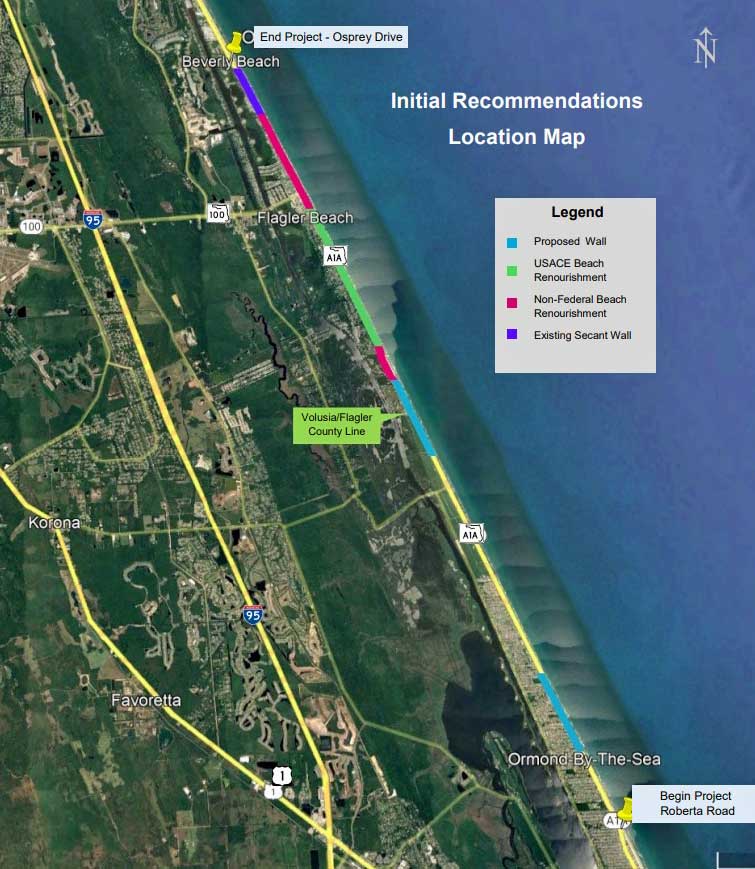
The Florida Department of Transportation’s much-anticipated plan to protect State Road A1A in Flagler Beach is almost anti-climatic, shifting much of the responsibility back to other governments.
The plan, disclosed today at a public meeting in Flagler Beach, will mostly rely on existing plans by the U.S. Army Corps of Engineers to rebuild 2.6 miles of beach and dunes south of the pier, and plans by Flagler County to rebuild beaches north and south of that stretch.
Notably, the preliminary plan rejects any additional rock revetments or sheetpile walls. Revetments are considered ugly and diminish beach areas. Sheetpile walls are not particularly sturdy and require ongoing maintenance and additions of sand, making them cheaper up front but costly in the long run.
“I’m always optimistic,” Flagler County Engineer Faith al-Khatib said today. “There is a benefit for Flagler County resident as much as for FDOT to protect everyone. So whatever we do here is a benefit for the state, for FDOT and also for the resident of Flagler County.” But, al-Khatib said, even the county is working on solidifying additional funding, “there are a lot of moving targets.”
The U.S. Army project is mostly funded and should start in a year, if with five times more sand than originally projected (1.6 million cubic yards of sand instead of 300,000 cubic yards), due to intervening erosion. New cost estimates are still being calculated. The Flagler County plans are partly funded, and their total cost is uncertain. But with the state transportation department’s backing, Flagler County would stands a higher chance of getting state dollars, especially now that the transportation department is seeing renourishment as its main protection for A1A.
The Transportation Department is not entirely out of the picture: it is planning a secant wall, or sea wall, on 1.3 miles of beach straddling the Flagler-Volusia county line, from half a mile north of Hybrid Road in Volusia to South Central Avenue in Volusia County. The Flagler County portion of the sea wall would extend some 3,200 feet.
The department built one such secant wall from North 18th Street in Flagler Beach to Osprey Road, completing it in 2019 as part of a $25 million project that also rebuilt a segment of A1A south of the pier after both areas were severely damaged by Hurricane Matthew in 2016.
The wall held up well during Hurricanes Ian and Nicole, though its sand cover had washed out even before those storms struck.
The secant wall at the south end of Flagler would be one of two. The department would build a 1.28-mile wall from Sunrise Avenue north in Volusia County. The department is estimating that the two walls together would cost roughly $100 million–a colossal, unexpectedly high cost that puts it well in range of beach renourishment costs over a long period. When costs of Flagler County’s Army Corps project were estimated a few years ago, stretched over the 50-year duration of the project, the figure was $100 million. That was to be both the federal and the local share. The costs have risen since, though by how much is unclear.
The Army Corps considered building sea walls, but ruled out the option “because the cost was two or three times [that of] beach and dune renourishment,” Jason Harrah, the project manager for Flagler’s Army Corps renourishment, said. “For the Corps, typically a beach and dune will do something very similar to a wall in a more environmentally friendly way.” Had DOT considered building a wall in the federal project area, the Corps would have likely pulled out its renourishment project, Harrah said.
Transportation department officials are presenting the proposals as “initial recommendations,” so they’re not set in stone. The department is still soliciting public input, as it was today at Flagler Beach’s Wickline Center.
“At the end of the day, they’re responsible for the preservation of A1A,” Flagler Beach City Commissioner Scott Spradley said today as he was attending the DOT meeting. “Nothing to do with the beaches, and most of the residents, their concern is the beaches. But you can’t have effective beaches without A1A there. So it’s these competing interests. As far as shifting responsibilities, that sounds like it’s still a developing issue.” Spardley said he was not surprised that “DOT would support handing some of this off to the county.”
The department has relied on some 100 written public comments to get to this stage, after holding public meetings in Volusia and Flagler County earlier this year. The aim, repeated by DOT officials, was to stop doing the same thing and expecting a different result. (See: “State Transportation Department to Flagler Beach: Simply Rebuilding A1A Again Won’t Do.”)
The cost of doing the same thing for two decades has been prohibitive, as a slide DOT is showing in one of its latest presentations indicates: going back to 2002, installing rock revetments, repairing washouts on A1A, rebuilding A1A in 2019, and carrying out “stabilization” projects has all cost over $39 million, not including the $20 million Flagler County spent to rebuild dunes after Ian and Matthew–dunes that, by the time Nicole and Ian struck, were long gone.
And not including the $15 million DOT has spent so far for emergency repairs since Ian and Nicole. Those emergency repairs have dumped more than 51,000 cubic yards of sand and 32,000 tons of rock along the Flagler and north Volusioa shorelines. The repairs are ongoing.
To end the cycle of repeating the same thing after every storm, DOT worked through what it calls a “strike team.” That team assembled representatives from Flagler and Volusia governments, the transportation department, the Army Corps, and the state Department of Environmental Protection and vetted proposals while listening to the public along the way. The framing principle was “resiliency”–how to build something that will last.
In developing the recommendations, the department considered several factors: roadway protection, initial costs and future maintenance costs, possibilities of sharing costs with other agencies, like the federal government, environmental permitting, aesthetics, impacts on wildlife, the environment, water quality, recreation, parking and public access, and the duration of construction.
Unsurprisingly, the public response following the meetings in January favored long-term solutions. (See: “Sea Walls, Granite, Dunes: FDOT Options to Strengthen A1A Are Nothing Flagler Hasn’t Seen Before.”) While responses at first blush seemed supportive of secant walls, on closer inspection, that support was based on a misunderstanding of how walls work, and whether the walls would provide as broad and aesthetically pleasing a beach as would beach renourishment.
The latter option is still the most favored, though it is also not much less expensive than secant walls. (See: “In Major Shift, Flagler Beach Residents Appear to Favor Sea Walls, But Misconceptions Abound.”)
![]()





























don miller says
it never works and never has. te base of the seawall will erode and collapse. i resent having to pay for greedy ocean front dwellers, time and time again. even the bible says don’t build your house on sand and they knew that way back then . yet, we persist in trying to beat it. let it go or let the home owners waste their OWN money.
Jeff says
Yep, I’m aware of that verse and have thought quite a lot about it. The verse really refers to people not building their lives on solid ground by serving Christ Jesus. And as a perk, I’m going to take the outstanding Flagler beach views and the pleasures of living in this community along with my solid life following Christ and his written words.
Maranatha!
Sam Adams says
We lived on Flagler Beach for many years. Watching sunrise over the Atlantic and sunset over the inter coastal is so special. It has to be one of the most beautiful spots on the planet. But given the volatility of recent hurricanes, I question living on a barrier island.
How many times are we going to rebuild A1A? Does anyone really think we can build walls to fight mother nature? How many times are we are going to restore beaches with gobs of sand?
Why not use this money to make people obliterated and soon to be obliterated whole. And continue this trend over the next ten or so years with the stipulation of no rebuilding on a barrier island. I am guessing it would be a whole lot cheaper in the long run than trying to outsmart mother nature
don miller says
why do we have to use our money to make them whole after their poor decision to build there which resulted in blocking the rest of us off the beach? when people don’t have to pay for the poor decisions, they boldly make even dumber ones that effect others negatively. let them pay.
Salty says
Come people don’t you understand when it comes to government appeasement THE MAJORITY ALWAYS PAYS FOR THE MINORITY,
These properties have been damaged by hurricanes 4 times in the last 10 years. The county has dumped enough sand to sure up the “PRIVATE BEACHFRONT” palace’s of the exclusion AIA Club a gated community could have been built like the Palm shaped designed ultra rich community in Dubai.
John Williams says
Respectfully, all of the folks making nasty comments just don’t get it. A1A is an evacuation route and needs to be protected. The city also depends on tourists and visitors and locals too. They spend money and they support the businesses on A1A. The town dies without its beaches and A1A, or at least it becomes a former shadow of itself and that would be a very sad day. Also, the homes on A1A pay a boatload more taxes, than the complainers do I bet, so please stop complaining about the homeowner and condo owners on A1A like they are evil. Imagine if all of those people you vilify didn’t have those homes and that tax base were gone, the city would have a hard time paying for the most basic of city services These homeowners are in fact big financial supporters of the city through their taxes. The Army Core of Engineers need to “engineer” the solution, which is the long term solution, and politics and small minds that only think about themselves need to respectfully get out of the way. Flagler Beach is special for the people that live here and we want to keep it that way. Big Florida beach towns have these same problems. Beaches erode and they rebuild the dunes, put in sea walls and dredge the beaches and they get it done. Flagler Beach will do the same.